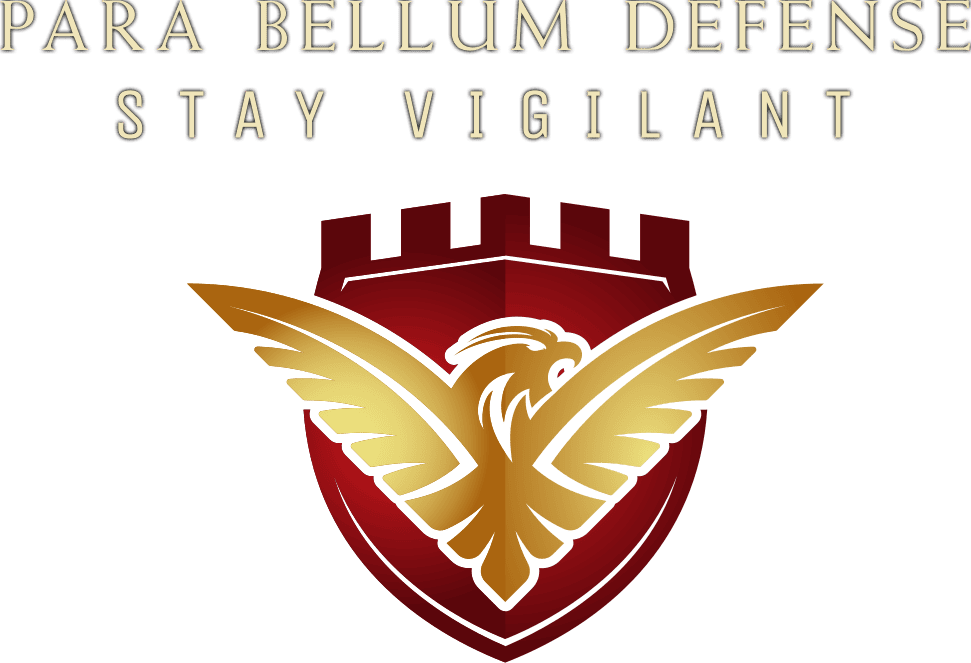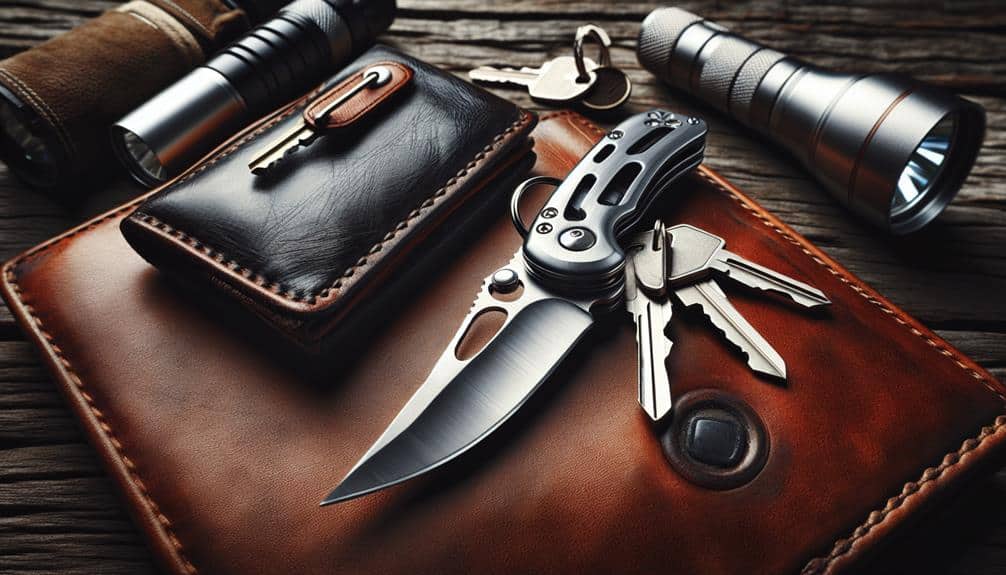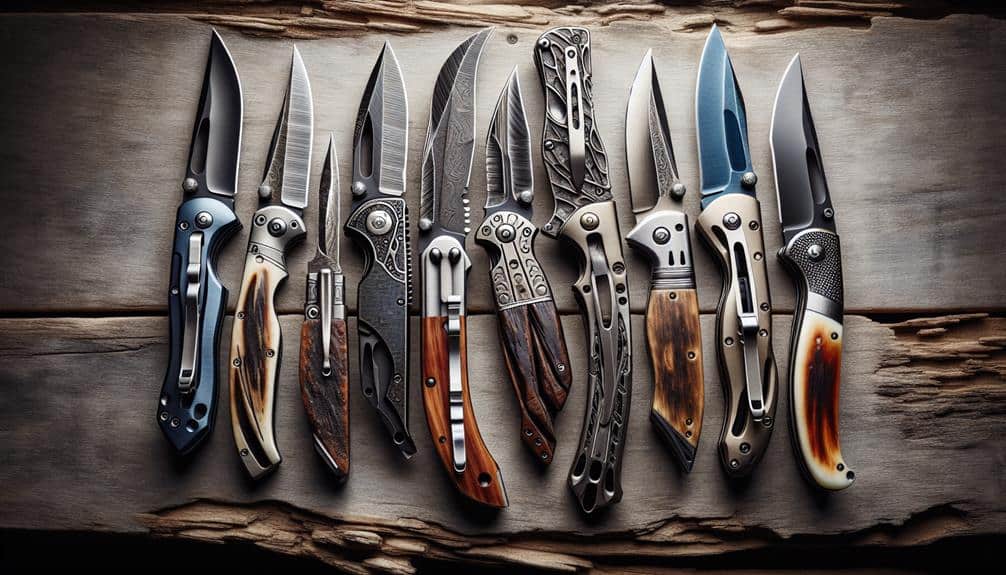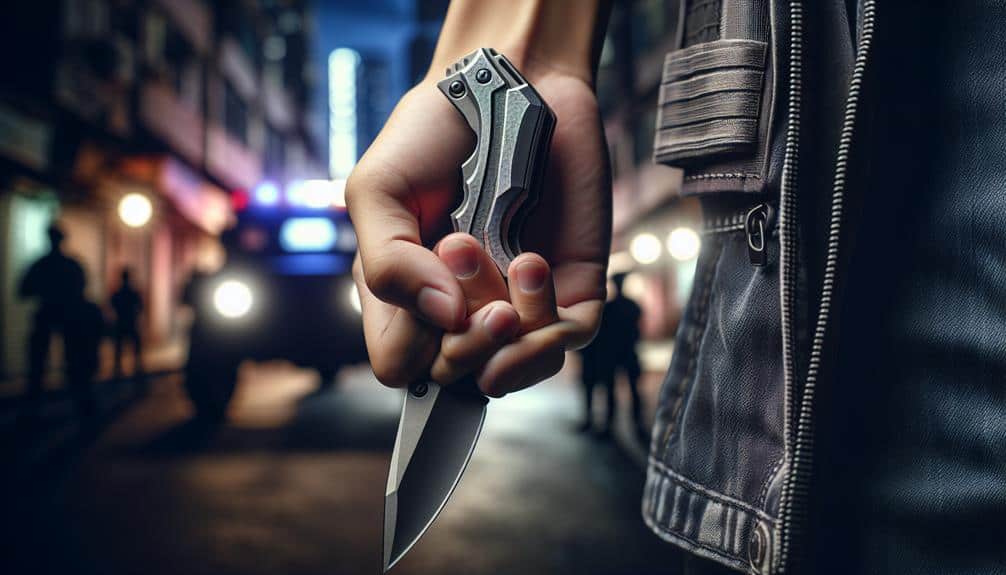
free shipping on orders over $25
We’re having a sale on all our products. Enter your email below to be notified about future sales.


We’re having a sale on all our products. Enter your email below to be notified about future sales.


With crime rates on the rise, carrying a pocketknife can be a real game-changer for your safety. Imagine, it’s not just a blade; it’s a trusty sidekick that can handle everything from cutting seatbelts in emergencies to fending off would-be attackers. They’re legal, affordable, and those versatile little tools fit right in your pocket, ready when you need them most. But be smart, okay? Know your local laws, and get some training. Trust me, the right skills can make all the difference. Ready to feel more secure and prepared? Let’s explore all the ins and outs!

In today’s world, personal safety concerns are on the rise due to increasing crime rates and fluctuations in societal violence. It’s no wonder you’re worried about staying safe.
One self-defense option people often consider is carrying a pocket knife. Now, I know what you’re thinking—doesn’t that seem a bit extreme? But given the current climate, it’s worth exploring.
When you’re out and about, you can’t always predict what might happen. Personal safety concerns are real, and being prepared is key. Imagine you’re walking home late at night, and someone suspicious is lurking nearby. Having a self-defense option like a pocket knife could give you peace of mind.
Of course, it’s not just about carrying any knife; you need to understand the risks and legalities involved. You don’t want to end up in more trouble than you started with. The decision to carry a pocket knife isn’t one to take lightly. It requires careful thought about your personal safety concerns and how comfortable you’re with using such a tool.
When you carry a pocket knife, you’re not just prepared for self-defense; you’ve got a tool that’s useful for countless daily tasks and emergencies.
These knives are often legal and affordable, making them a budget-friendly option for anyone concerned about their safety.
Plus, their versatility means you’ll always have a handy device for everything from opening packages to handling unexpected situations, all while staying discreet.
A pocket knife’s visible presence can quickly deter potential attackers, offering you a practical tool for self-defense. When you carry a knife, it sends a clear message that you’re not an easy target. It’s like having a tiny security guard in your pocket, ready to assist when needed.
But that’s not all. In emergencies, pocket knives are lifesavers. Imagine you’re walking alone at night, and someone approaches you with ill intentions. The mere sight of your knife can make them think twice. Plus, it’s not just for self-defense. Picture yourself stuck in a jam where you need to cut a seatbelt or open a stubborn package. Your trusty pocket knife becomes your go-to tool.
Here are three key benefits of carrying a pocket knife:
Considering the legal and budget-friendly aspects, pocket knives present a practical self-defense tool that’s both accessible and economical. Many places allow you to carry a pocket knife, provided you follow specific blade length regulations. This makes it a great choice if you’re looking for a self-defense option that doesn’t require a law degree to understand the rules.
You don’t need to break the bank to get a quality pocket knife. You can find reliable ones for as low as $20 to $50. Compare that to the cost of a firearm, and you’ll see why a pocket knife is a much more budget-friendly option. Plus, there’s no need to worry about the ongoing expenses of ammunition or specialized storage.
Legal laws surrounding pocket knives are generally less restrictive than those for firearms. This means fewer headaches and more peace of mind. You won’t have to navigate a maze of complex regulations, which can be a huge relief.
Pocket knives offer unparalleled versatility for a multitude of everyday tasks. Imagine needing to open a stubborn package, cut a piece of rope, or slice an apple for a quick snack—your handy pocket knife has got you covered. Its compact size and lightweight design make it an ideal tool for everyday carry, making sure you’re always prepared for whatever life throws your way.
Beyond these basics, many pocket knives come loaded with extra tools that add to their utility:
Plus, having a pocket knife can even play a role in effective self-defense, giving you peace of mind.

When you carry a pocket knife for self-defense, you’re not just holding a tool; you’re shouldering some serious risks.
Imagine fumbling with the blade and accidentally cutting yourself, or worse, someone else.
Plus, you’ve got to navigate a maze of laws—what’s legal in one place might get you in big trouble somewhere else.
Understanding local laws and regulations about knife carry is vital to avoid legal trouble and guarantee you’re compliant with restrictions. Failing to know your local laws can land you in hot water, even if your intentions are good. Each place has its own rules about the type, size, and way you can carry a knife, and violating these can lead to serious consequences.
It’s not just about knowing the law; having proper training is essential too. Without it, you might misuse the knife, which could escalate a situation instead of defusing it. Here’s what you need to keep in mind:
In short, while carrying a knife for self-defense might seem like a good idea, it’s a responsibility that requires you to be both knowledgeable and prepared. Ignorance isn’t bliss here—it’s a legal risk.
Accidental injuries from carrying a knife can arise quickly if you aren’t cautious and well-trained. A self-defense tool like a pocket knife can be handy, but it comes with risks. Mishandling or improper storage can lead to cuts or puncture wounds.
Imagine envisioning reaching into your pocket and feeling a sharp blade instead of your keys—that’s not a pleasant surprise! If you’re not experienced with knives, you might accidentally harm yourself or others. Envision this scenario: you’re trying to use your knife in a tense situation, and your hands are shaking. One wrong move, and you could end up with an unintended injury. It’s like playing with fire; it can burn you if you’re not careful.
Carelessness is another big factor. Maybe you’re in a hurry, and you forget to properly close your knife. Next thing you know, you’re dealing with a nasty cut. To prevent these accidental injuries, it’s important to understand the risks and handle your knife with caution.
Educate yourself, practice safe handling, and always stay aware of your surroundings. After all, a self-defense tool should keep you safe, not put you in harm’s way.
Understanding the complex web of knife laws is vital to guarantee you’re legally protected while carrying a pocket knife for self-defense. It’s important to know the rules to avoid trouble.
Imagine carrying a knife, feeling safe and prepared, only to find out you’ve broken a law. That’s a stress you don’t need!
Different states have different rules, and what’s okay in one place might get you in hot water somewhere else. Law enforcement officers aren’t always lenient if you’re caught unaware.
Here’s a quick rundown to help you navigate:
Keep these points in mind, and always check your local laws to stay on the right side of the law. A little homework now can save you a lot of headaches later!

Selecting the right pocket knife for self-defense requires careful consideration of factors like size, weight, and blade material. You want something that’s easy to carry every day, so consider a knife that’s compact and lightweight. Don’t go for anything too bulky, or you might end up leaving it at home when you need it most.
The blade material is vital. Stainless steel and high carbon steel are both solid choices because they’re durable and maintain a sharp edge. You don’t want a blade that dulls easily, trust me.
Next, think about the locking mechanism. A liner lock is a popular choice because it keeps the blade securely in place when open, which is essential for safety and effectiveness. You don’t want a knife that snaps shut unexpectedly!
Blade shape matters too. Whether you pick a tanto, drop point, or clip point depends on your specific cutting needs. A tanto blade is tough and good for piercing, while a drop point is versatile and user-friendly.
Once you’ve chosen the right knife, getting professional training is the next step to guarantee you’re ready to use it effectively and safely in self-defense situations. Proper training enhances your proficiency, ensuring you can handle the knife without causing accidental harm to yourself or others. Plus, you’ll gain confidence knowing you’re prepared.
Training is essential for several reasons:
Imagine you’re in a tough spot, adrenaline pumping, and you need to act fast. Without training, you might fumble, but with it, your movements can be smooth and controlled. It’s not just about wielding a knife; it’s about mastering it.
Seek out reputable instructors or programs that focus on self-defense. They can teach you the nuances of knife handling, from grip and stance to strikes and defenses.

De-escalation tactics are essential skills that can help you avoid physical confrontations and resolve conflicts peacefully. When it comes to self-defense, it involves more than just carrying a pocket knife. Knowing how to diffuse a tense situation can mean the difference between walking away safely and getting into a dangerous altercation.
First, let’s talk about active listening. This means really paying attention to what the other person is saying, nodding, and using phrases like, “I understand,” to show empathy. It’s amazing how much a calm, understanding demeanor can cool things down.
Next, there’s body language. Keep your hands visible and your posture non-threatening. People pick up on these cues, and they can either escalate or de-escalate the situation.
Staying calm is vital. If you’re jittery and anxious, it’ll only make things worse. Take deep breaths, keep your voice steady, and maintain eye contact. Showing that you’re in control can actually help you be in control.
In essence, de-escalation tactics are a key part of self-defense. They allow you to protect yourself without having to resort to physical force. So, while it’s great to be prepared, remember that sometimes, words are your best weapon.
While mastering de-escalation tactics is invaluable, it’s equally important to explore non-weapon alternatives for personal safety. Sure, carrying a folding knife or any knife designed for self-defense might give you peace of mind, but there are other ways to stay safe without resorting to weapons.
Traveling in Groups: There’s strength in numbers. Walking with friends can make you less of a target. Imagine strolling with your squad, laughing and chatting. It’s not just fun, it’s safer too!
Well-Lit Areas: When you’re out alone, stick to well-lit and populated spots. Darkness can be a friend to those with bad intentions. Bright streets and busy places make you less vulnerable and more visible.
Personal Alarms: These little gadgets can be lifesavers. Imagine a loud beep that startles a would-be attacker and alerts everyone around you. It’s like having a pocket-sized hero at your side.

Knives frequently serve multiple practical purposes beyond self-defense, enhancing your efficiency in everyday and survival tasks. Imagine you’re out camping and you need to start a fire. Your knife, especially if it’s got a fixed blade, can be vital for striking a ferro rod to ignite sparks.
It’s not just about survival; think about preparing a meal. Cutting meat, slicing vegetables, and even opening packages become a breeze when you carry a reliable knife.
Now, let’s talk about hunting. If you’re into the great outdoors, your knife is indispensable for skinning animals and setting traps. Building shelters or clearing a path through dense brush? Your knife’s got you covered. These tasks are much easier when you’ve got a sturdy, fixed blade in hand.
Different blade shapes also have their perks. For self-defense, a pointed tip can be more effective, but for daily tasks, a straight edge works wonders. You’ll find that carrying a knife not only makes you feel prepared but also boosts your efficiency in various situations.
You should consider carrying a pocket knife for self-defense if you’re aware of the legal considerations and meet training requirements. It’s a discreet option, but understanding laws and proper training are essential for effective and safe use.
You should carry a pocket knife because it offers everyday utility and can be invaluable in emergency situations. It’s compact, lightweight, and versatile, ensuring you’re always prepared for daily tasks or unexpected challenges.
A knife is good for self-defense if its blade design guarantees effectiveness and its handle ergonomics provide a secure grip. Look for sturdy locking mechanisms and quick deployment features to enhance your safety in emergencies.
Carrying a knife might make you feel safer, but it doesn’t guarantee protection. You must consider legal implications and the psychological impact. Proper training and awareness of local laws are essential to avoid unintended consequences.
Para Bellum Defense
133 Palm Drive
Winter Haven, FL 33880
Telephone: 585-284-6669
